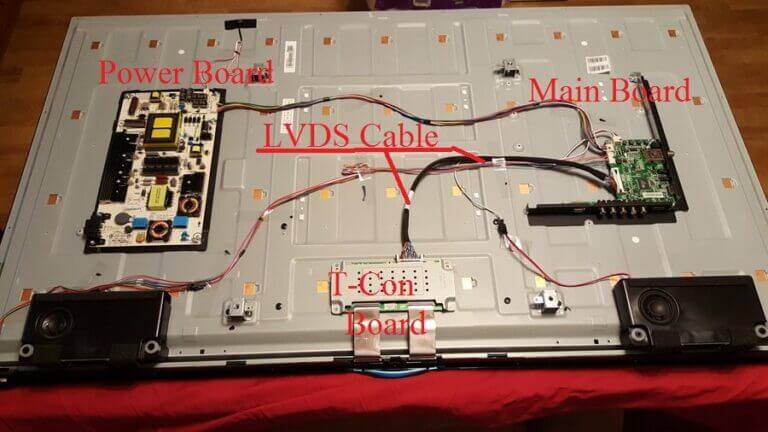We watch TV as a nation for a long time every day without really knowing how that picture is displayed on the screen, and it is the same for computer monitors as they use exactly the same technology. In fact, they only really differ with the quality of the display (monitors are designed for closer working and TVs for viewing at a distance)

TV and monitor hardware
Your TV and monitor uses the same components to display the picture and to play music (if your monitor is equipped with speakers)
The Power board
The power board takes alternating current from the mains and chops it up into slices of power before converting those slices into direct current to power the main board and the screen.
A complex circuitry is involved to slice the alternating current into the right amount of voltage and current required and the power board provides a minimal amount of power to the main board to power it when in standby and waits for one of the pins to go high to start the normal power output to the main board.
The Main board
The main board (which is called a motherboard in desktop PCs and logic board in Apple products) is an Android based computer that displays the video in a web page to the user. This enables picture-in-picture features.
There are convertor chips that take the various inputs and convert the output into LVDS or Low Voltage Differential Signal to pass to the T-Con.
The T-Con
The T-Con board (Timing Controller) converts the digital signals from the LVDS connector and converts them into row and column signals which are sent to the LCD display.
While the input to the TV comes in at different resolutions and frame rates, the LCD display panel only supports one timing system and one resolution, so the T-Con board is responsible for this. There is often two outputs, the left and right output.
LCD display
Both LCD and LED TV (and monitor) technology uses a LCD display. They just use different back lights to illuminate the screen. LCD uses a fluorescent tube to provide the light source and LED uses small LEDs that are spaced out across the back (or in the metal outsides on smaller screens) and then special Fresnel lens sheets diffuse the light evenly across the back of the LCD. This is powered directly from the power board.
LCD actually blocks light coming through the panel instead of actually displaying it. Rows and columns are fed from the T-Con to the individual LCD parts that control the light levels for the three colours.
OLED display
OLED TVs don’t rely on an LED backlight, as the display panel itself is made from LEDs that produce the display and the light output in one unit. This makes them considerably thinner and lighter than traditional LED TVs.
Troubleshooting
There are a number of faults that TVs and monitors can develop:
- Screen problems like flickering or dim screen, sound with no picture or the other way around, also clicking and turning off on its own is usually a power board issue. If you hear a high pitch noise, then it’s the capacitors on the power supply.
- If the screen doesn’t turn on with the remote or buttons, if the logo is stuck or the set doesn’t respond after 30 minutes of being on or off, then it’s the main board. If the ports don’t function or if you hear a loud squeal or chirp, then it’s the main board.
- If you get no picture but you can hear sound, it could be the T-Con board has gone bad, especially if the backlight works.
- Display problems like vertical or horizontal lines, then it’s the LCD panel.
- Part of the screen is dim, you have a backlight issue.
Conclusion
If your TV has developed a fault, it can be repaired easily by swapping out a defective part. Some main boards are repairable on eBay, you send the board away and the components are replaced and the board comes back in about a week’s time.
Most eSpares companies stock replacement power, main boards and t-con boards. However, replacing the panel itself may be more expensive than the TV is worth.


